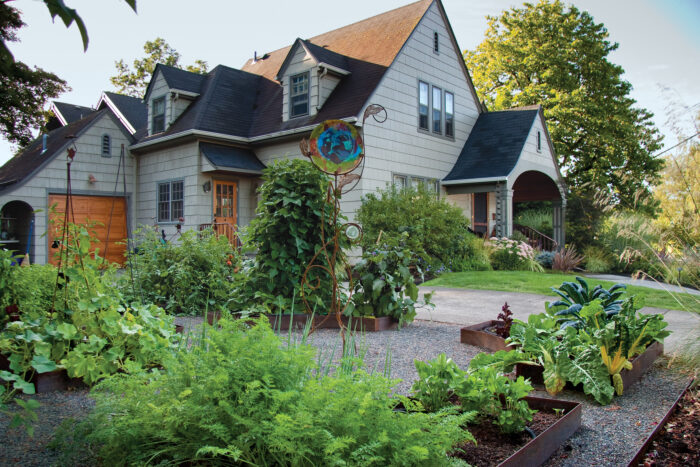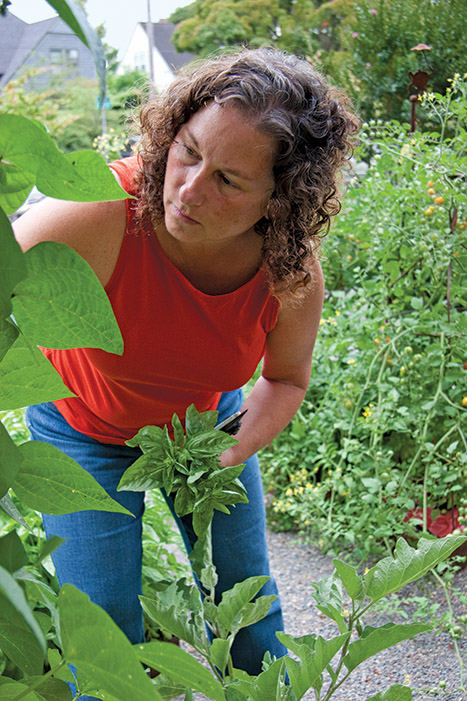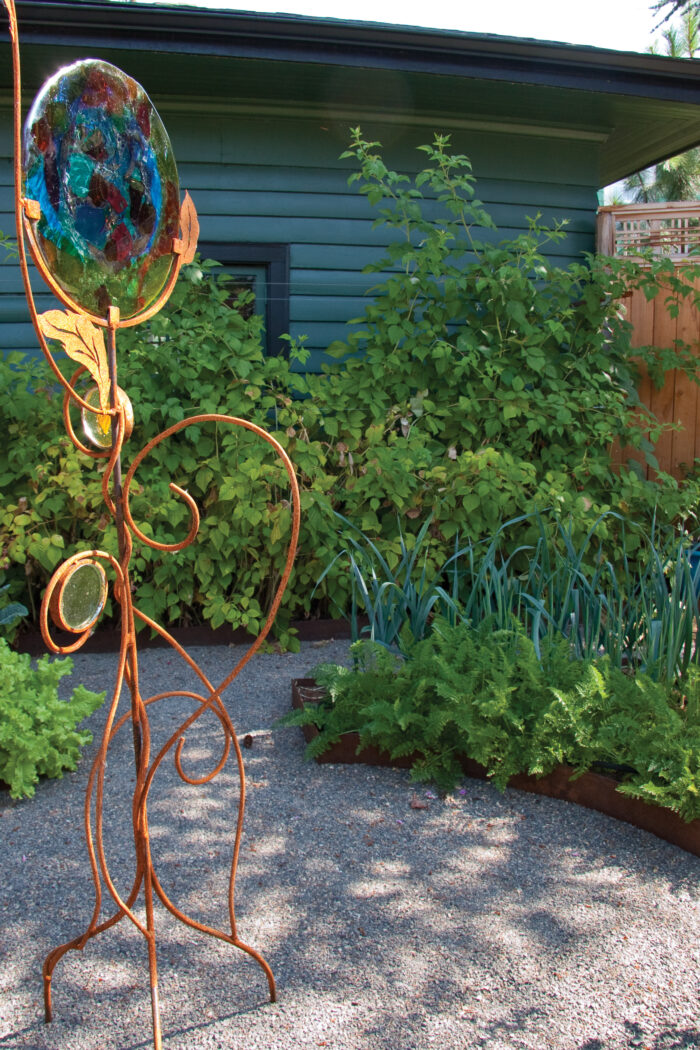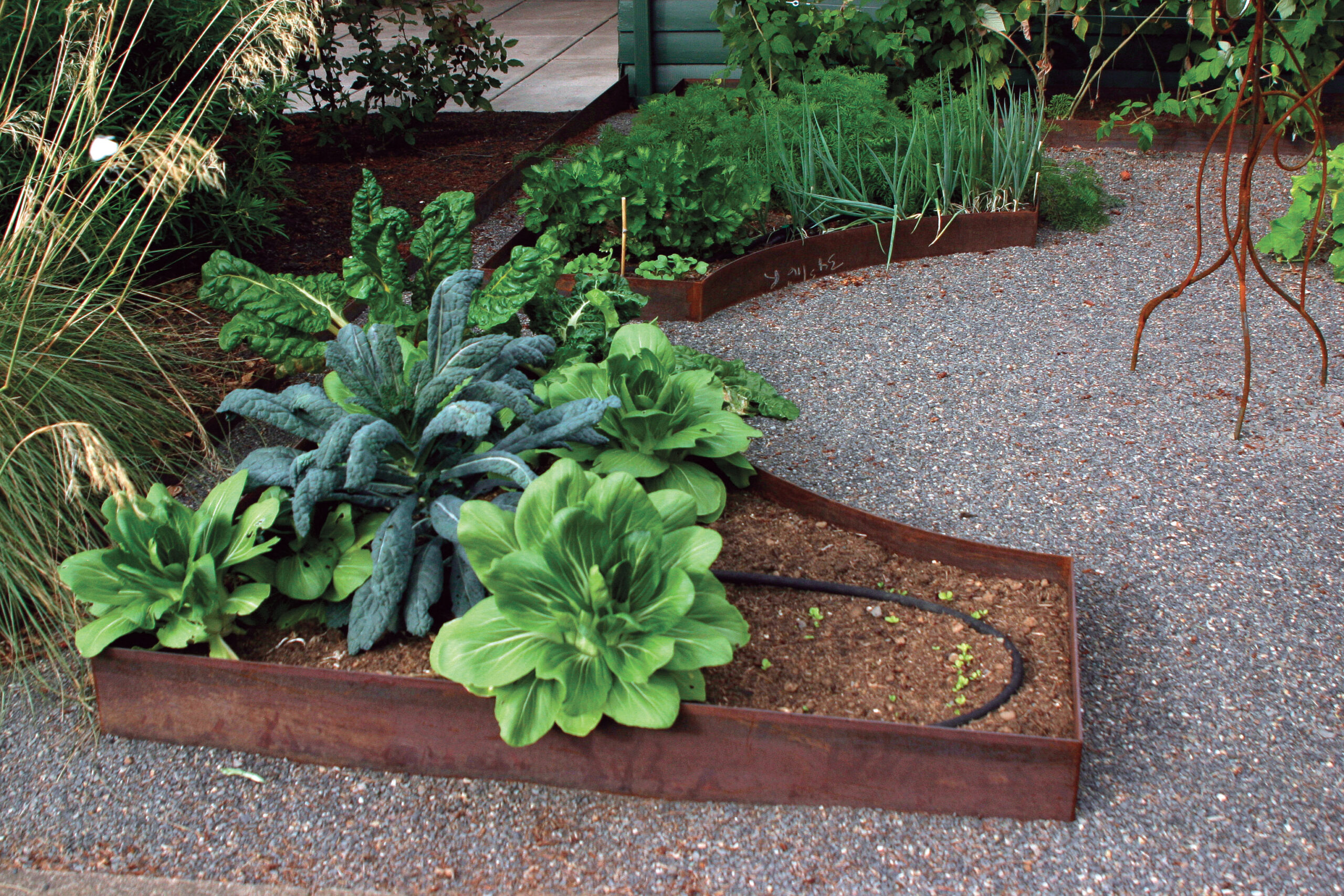Put Your Veggies in the Front Yard
Grow beautiful edibles in the public eye with these design tips

It seems like everyone wants to grow vegetables these days, but many homeowners are reluctant to do so in their front yard, even when it happens to be the sunniest, most desirable spot. After all, vegetable gardens can get chaotic by the end of the growing season, and they tend to look stark and bare in the off-season. Front-yard veggie gardens, though, can be created that have multiseason appeal, such as the garden that I designed for Kristan and Ben Sias in Portland, Oregon.
 Kristan (photo right), an avid cook, had been growing edibles in a small, out-of-the-way corner of her front yard for years. The location’s size and limited sunlight prevented her from growing the amount and variety of food that she wanted. This new design and location, however, offers plenty of room for edibles—plus, a pleasing streetside view.
Kristan (photo right), an avid cook, had been growing edibles in a small, out-of-the-way corner of her front yard for years. The location’s size and limited sunlight prevented her from growing the amount and variety of food that she wanted. This new design and location, however, offers plenty of room for edibles—plus, a pleasing streetside view.
Let the space inspire the design
The layout of the Siases’ vegetable garden works with the shape of their driveway, which curves along the upper portion. A 20-foot-wide section of the yard is available in the front, tapering to a narrow 6½-foot-wide strip at the rear. A mix of straight lines and curves makes the most of this unique space. A front-yard vegetable garden requires as much attention and forethought as to a highly visible ornamental garden, especially when space is at a premium. Start planning your layout by considering the shape of your space; employ curves, angles, and straight lines to create an efficient and artful design.
The raised beds are laid out in a grid of 5-foot squares modified with curves, resulting in a geometric pattern with pleasing and practical proportions that ground the garden. The geometric grid also instills a sense of order and visual appeal when the garden is overflowing with produce, as well as when it’s dormant. An additional interior curve in the central garden space not only lends artistic flair but also enlarges the central intersection, which would otherwise be too narrow and awkward to maneuver within.
When designing a garden layout, plan for adequate pathways and points of access so that you have room to work in the garden. Keep your main pathway at least 3 feet wide to maneuver within—supplemental pathways can be narrower yet still serviceable. Raised beds wider than 4 feet are difficult to work in, but incorporating enough usable pathways to provide access from multiple sides makes tending and harvesting easier.
Pick materials for style and function

Although steel is great, other materials can be used successfully, too. Cedar and composite lumber work well for beds that utilize straight lines and regular angles. Brick or natural stone can be used to create long-lasting edging that feels organic. A hedge of dwarf boxwood can serve as a living evergreen boundary if you’re not using raised beds and are willing to put in a bit more labor to maintain it. Remember, however, to take the thickness of your edging material into consideration. Natural stone or a planted edge will be tricky for small beds because they’ll take up a greater percentage of your growing area. Regardless of whether you have in-ground beds or raised beds, use attractive weatherproof materials to define them. The Siases’ garden uses a great material: steel. It is low maintenance, lasts indefinitely, and is space-efficient. I also like the warm, earthy tones of rusted steel. The flat-bar steel used in the Siases’ garden is only 3/16 inch thick, making it easy to shape. This allows the design to steer away from straight lines toward graceful curves and more complex geometric shapes. You can opt to create the beds yourself, but because of the complex layout employed in this design, the Siases hired a local contractor to make and install the steel frames. The do-it-yourself route will require you to locate a local industrial-materials supplier or metal fabricator, which may be easier to find if you’re located near a major city. You’ll also want to call ahead to make sure that the company doesn’t operate strictly as a wholesale supplier.
With the raised-bed or border material chosen, pathway materials come next. The paths of the Siases’ garden use compacted gravel to provide all-season access and to achieve a neat, crisp appearance that’s especially attractive next to the warm tones of rusted metal. The gravel, the steel, and the adjacent driveway all have a tendency to capture and radiate heat, a boon when growing heat-loving veggies, such as tomatoes or peppers.
Add ornaments that have a purpose
Trellises, decorative cages, and garden ornaments provide the finishing touch to a garden. The open central axis of the Siases’ garden incorporates a focal point to add interest to the space both during and after the growing season. The Siases commissioned an art-glass piece by two local artists. The glass underscores the garden’s unified color theme (created by the combination of materials, structures, and ornaments), which helps ensure that all the details in the garden come together as a whole. A similar artistic display can be achieved in your own garden by incorporating a unifying central focal point, such as a pot, birdbath, fountain, or other decorative elements.
Working ornamentation, like trellises and cages, saves space and gives your plants support—but they need not be ordinary or eyesores. The Siases’ garden uses circular tomato cages made by a local artisan; the cages’ rusted-steel texture blends perfectly with the edging of the beds.
Aesthetics aside, most support structures need to be easy to move from bed to bed. While the layout and position of your beds are constant, the types of plants grown in them will vary from year to year as you rotate your crops.
Many plants will grow on a structure where they’re encouraged to twine and climb. The Siases’ espaliered apples along their boundary fence are a decorative and space-saving way to incorporate fruit. Because space is tight in many city gardens, growing vertically provides extra room, and the varying heights bring added visual interest to the garden.
Be careful, though, not to overdo it. Too much ornamentation can create chaos and visual clutter. The cohesiveness of the Siases’ garden can be at least partly attributed to a disciplined color palette and limited materials. Choose similar themes and stick to them. The results will give you almost as much pleasure as eating your own homegrown fruits and vegetables.
3 steps transform a blank slate into a dream garden
 Before |
 After |
Moving your veggie garden from the background to the foreground takes some effort. A permanent raised-bed design for a front-yard location requires more planning the first time around than an annual backyard veggie garden. This extra effort and forethought pays off in the long run, however, requiring less labor in the years to come. Follow these three steps to help transform your available front-yard space into an amazing edible garden:
1. Plan the layout
Consider a number of options before landing on a final design. Brainstorm with tissue overlays on a base map—this lets you quickly and freely rough out choices. Once an idea resonates, firm up the preferred concept by fine-tuning the dimensions and determining construction details. Keep in mind that the human eye is able to pick up remarkably small deviations in alignment. Geometric patterns require a bit more rigid planning and a deeper understanding of your site than nongeometric ones.
2. Shape the beds
If you decide to incorporate tight curves in your design, you will need to have a fabricator roll (shape) the steel. Don’t be dissuaded by this extra step. Steel shapes can be mathematically described and then fabricated in a straightforward process, which shouldn’t break the bank if you keep your design relatively simple.
3. Choose the plants
Edibles that will be on display in your front yard should bring more to the table than just good eating. Think foliage, flowers, and fruit. Attractive foliage is readily available in plants such as kale, rhubarb, artichoke, chard, and lettuce. The flowers of nasturtiums, scarlet runner beans, and espaliered apples provide colorful blooms, while fruit such as ‘Sun Gold’ tomatoes, eggplant, peppers (especially red ones), and blueberries provide additional interest.







Comments
I have a garden with flowers and vegetables on our double wide mobile home. I call it my "How to get every penny out of you Lot Rent Garden!"
Log in or create an account to post a comment.
Sign up Log in